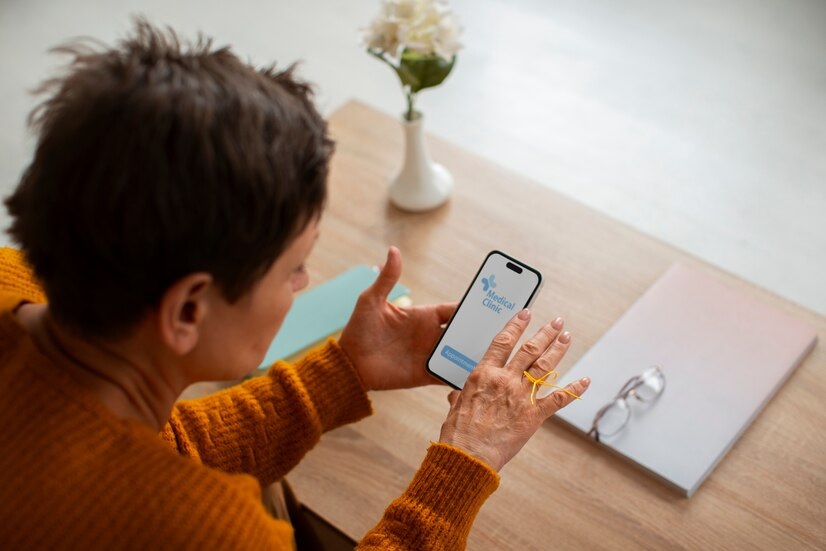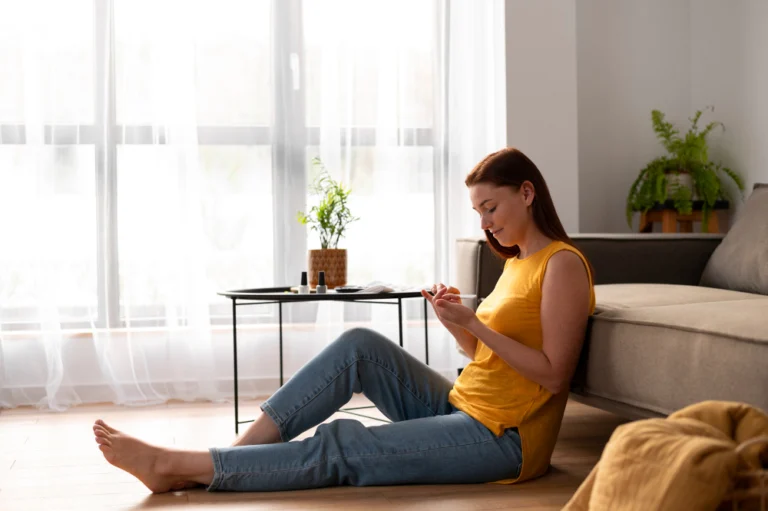
Is your smartphone the first thing you see in the morning and the last thing you touch at night? You’re not alone. In our hyper-connected world, the constant stream of notifications, emails, and social media updates has left many feeling digitally drained and perpetually distracted.It’s the modern paradox: using your phone to use your phone less. To combat digital burnout, smartphone makers have built-in Digital Wellbeing features designed to help you unplug and reclaim your focus.
The very device meant to connect us often leaves us feeling disconnected from the present moment. This article explores the innovative new features in smartphones designed to help you unplug, moving beyond simple notification silencers to offer sophisticated tools for reclaiming your time and attention.
The irony is palpable: we’re using our phones to save us from our phones. But as our awareness of digital burnout grows, so does the sophistication of the tools at our disposal.
Forget generic “digital detox” advice; we’re diving deep into the native features baked into your phone’s operating system and the groundbreaking third-party apps that offer a real chance at a healthier relationship with technology.
We’ll explore how these tools work, the psychology behind their effectiveness, and even some contrarian viewpoints on the “unplugging” movement.

The Evolution of Digital Wellbeing: From Simple Timers to Intelligent Assistants
The concept of digital wellbeing is no longer a niche concern; it’s a mainstream movement. Smartphone manufacturers, once focused solely on maximizing engagement, have pivoted to providing users with powerful tools to manage their screen time. This shift marks a significant evolution from basic app timers to a more holistic, intelligent approach to digital wellness.
These are not your rudimentary “turn off notifications” settings of yesteryear. We are now seeing a new generation of features that learn your habits, anticipate your needs, and actively create friction to curb mindless scrolling.
Early iterations of digital wellbeing tools, like the initial versions of Apple’s Screen Time and Google’s Digital Wellbeing, were primarily diagnostic. They showed you the stark reality of your phone usage with cold, hard data: hours spent on specific apps, the number of times you unlocked your device, and the barrage of notifications you received.
While eye-opening, this information often induced guilt without providing a clear path to change. Today’s features are far more proactive. They are designed to empower you to set meaningful boundaries and automate your digital detox.
Think of these new features as a friendly digital assistant dedicated to your mental clarity. They can transform your vibrant, attention-grabbing screen into a muted, grayscale canvas that’s far less appealing for late-night Browse. They can create “Focus Modes” that are highly customizable, allowing you to define not just which apps are off-limits, but also which people can reach you and what your home screen looks like during focused work sessions.
This level of granular control is a game-changer, moving beyond a one-size-fits-all approach to a personalized strategy for unplugging. For example, during “Work Mode,” you might only allow emails from your boss and calls from your partner, while your social media apps are completely hidden from view. This intelligent filtering reduces the cognitive load of constantly deciding what deserves your attention.
Deep Dive: The New Unplugging Features in Android 15
Android has long been a proponent of digital wellbeing, and with each new iteration, its suite of tools becomes more robust. Android 15 continues this trend, refining existing features and introducing new ones aimed at giving users more control over their digital lives. The core philosophy is to make unplugging an intuitive and integrated part of the user experience.
One of the most significant enhancements in Android 15 is the expanded functionality of Focus Mode. It’s no longer just about pausing distracting apps. You can now create multiple Focus Mode profiles with varying levels of restriction. For instance, a “Reading Mode” might grayscale your screen, silence all notifications except for those from your e-reader app, and even enable a warm, eye-comfort display.
A “Family Time” mode could block work-related apps and notifications, ensuring you’re fully present with your loved ones. This level of customization makes it a far more practical tool for everyday life than a simple on/off switch.

Key Features in Android 15’s Digital Wellbeing Suite:
- Enhanced Focus Modes: Create multiple, customizable profiles for different activities (work, reading, family time) with specific app and notification restrictions.
- Granular Notification Control: Android 15 offers more intuitive ways to manage notifications, allowing you to easily silence non-essential alerts and prioritize those that matter most. The system is also getting smarter at identifying and suggesting “gentle” notifications that don’t vibrate or appear on your lock screen.
- Proactive “Heads Up” Feature: This feature, which detects when you’re walking while looking at your phone, is becoming more intelligent. It can now be integrated with other apps and system settings to provide more timely and relevant reminders to be aware of your surroundings.
- Improved Bedtime Mode: Beyond just turning your screen to grayscale, Bedtime Mode in Android 15 can now integrate with smart home devices, dimming your lights and adjusting your thermostat to create an optimal sleep environment.
A subtle but powerful feature that continues to be a cornerstone of Android’s unplugging toolkit is Grayscale Mode. By stripping away the vibrant colors that app developers use to hijack our attention, this feature makes your phone significantly less appealing. It’s a simple psychological trick that can dramatically reduce mindless scrolling.
Apple’s Walled Garden of Serenity: New Features in iOS 18
Apple has always curated a more controlled user experience, and its approach to digital wellbeing is no different. With iOS 18, Apple continues to build upon its powerful Screen Time and Focus features, aiming to create a “walled garden of serenity” where users can easily disconnect from the digital noise.
A key development in iOS 18 is the increased intelligence and automation of Focus modes. Your iPhone can now learn your daily routines and suggest when to activate specific Focus modes. For example, when you arrive at the office, your phone might prompt you to turn on “Work Focus.” When you open a meditation app, it might suggest a “Mindfulness Focus.” This proactive approach removes the friction of having to remember to activate these modes manually.
Furthermore, the customization of Focus modes has reached a new level. You can now design entirely different Home Screen layouts for each Focus mode. Your “Work Focus” Home Screen might only display productivity apps, while your “Personal Focus” Home Screen could feature your favorite social and entertainment apps. This creates a powerful mental separation between different aspects of your life, all on the same device.
Highlights of iOS 18’s Unplugging Capabilities:
- Intelligent Focus Suggestions: Your iPhone can now learn your habits and proactively suggest activating Focus modes based on your location, the time of day, or the apps you’re using.
- Custom Home Screens for Focus Modes: Design unique Home Screen layouts for each Focus mode, displaying only the apps and widgets relevant to that activity. This helps to create clear boundaries between work and personal time.
- Enhanced Notification Summaries: iOS 18 improves upon the notification summary feature, using AI to group and prioritize your alerts more effectively, so you can catch up on what you missed without being overwhelmed.
- Downtime and App Limits: These core features of Screen Time remain essential tools for setting boundaries. You can schedule “Downtime” when only approved apps are available, and set daily time limits for specific app categories or individual apps.
Beyond the Built-in: The World of Third-Party Unplugging Apps
While the native tools in Android and iOS are incredibly powerful, a thriving ecosystem of third-party apps offers innovative and often more radical approaches to unplugging. These apps cater to specific needs and philosophies, from gamifying your focus to transforming your smartphone into a minimalist device.
For those who need an extra push, apps like Forest offer a creative incentive to stay off your phone. When you want to focus, you plant a virtual tree. If you leave the app, your tree withers and dies. Over time, you can grow a virtual forest, a visual representation of your focused work. This gamified approach can be surprisingly effective at building healthier habits.
For a more drastic transformation, minimalist launchers like Blank Spaces and Minimalist Phone can completely redesign your smartphone’s interface. They replace the colorful, icon-filled home screen with a simple, text-based menu, stripping away the visual cues that trigger mindless app usage. This approach forces you to be more intentional about how you use your phone.
Here’s a look at some of the most innovative third-party apps for unplugging in 2025:
- Forest: Gamify your focus by planting virtual trees that grow while you work and wither if you get distracted by your phone.
- Opal: This app uses a combination of app blocking, scheduling, and personalized interventions to help you reduce your screen time.
- Blank Spaces: A minimalist launcher that replaces your home screen with a clean, text-based interface to reduce distractions.
- One Sec: This app introduces a brief pause before opening distracting apps, giving you a moment to reconsider whether you really need to open them.
- Freedom: A powerful app and website blocker that works across all your devices, creating a distraction-free environment for focused work.
A Contrarian View: Are Digital Wellbeing Tools Just a Band-Aid?
While the proliferation of features to help us unplug is a positive development, some critics argue that they are merely a Band-Aid on a much larger problem. They contend that these tools place the onus of responsibility on the individual user, while the underlying design of apps and smartphones remains inherently addictive.
The “attention economy,” as it’s often called, is built on keeping us engaged for as long as possible. App developers employ sophisticated psychological techniques, from variable reward schedules (like the pull-to-refresh mechanism) to social validation loops (likes and comments), to keep us coming back for more.
In this context, are digital wellbeing tools simply a way for tech companies to appease our concerns without fundamentally changing their business models?
This perspective suggests that true digital wellness requires a more systemic shift. It calls for a move away from an advertising-driven model that incentivizes maximizing screen time, towards a model that prioritizes user well-being. While we may not be there yet, the growing demand for unplugging features is a clear signal to the tech industry that users are seeking a healthier balance.
Furthermore, some research suggests that simply disabling notifications might not be the panacea we hope for. A 2025 study in the journal Media Psychology found that turning off notifications didn’t significantly reduce the amount of time people spent on their phones.
This suggests that our phone usage is often driven by deeply ingrained habits, not just external triggers. This is where features that create friction, like the “One Sec” app’s pause, can be more effective than simply silencing alerts.
A Practical Framework for Your Digital Detox
Ready to put these new features into practice? Here’s a simple framework to help you create a personalized digital detox plan:
The 3-Step “Unplug and Reconnect” Framework:
- Audit and Acknowledge:
- Use your phone’s built-in digital wellbeing dashboard (Screen Time on iOS, Digital Wellbeing on Android) to get a clear picture of your current usage.
- Identify your biggest time-wasting apps and the times of day you’re most likely to get lost in your phone.
- Don’t judge yourself; simply acknowledge your habits.
- Configure and Customize:
- Set up personalized Focus Modes for different areas of your life (work, personal, sleep, exercise).
- Create custom Home Screens for your most important Focus Modes to reduce visual clutter.
- Set realistic App Limits for your most problematic apps. Start with a small reduction and gradually decrease the time.
- Schedule Downtime for the evenings and weekends to create dedicated phone-free periods.
- Turn your screen to Grayscale, especially in the evenings, to reduce its allure.
- Experiment and Evolve:
- Your digital habits won’t change overnight. Be patient with yourself and be willing to adjust your settings as you go.
- If you find yourself constantly overriding your App Limits, consider trying a more restrictive third-party app.
- Pay attention to how you feel when you spend less time on your phone. Notice any improvements in your focus, sleep, or overall well-being.
- Remember, the goal is not to eliminate your phone from your life, but to use it more intentionally.
By leveraging these powerful new features, you can transform your smartphone from a constant source of distraction into a tool that truly serves you. It’s time to move beyond “Do Not Disturb” and embrace a more nuanced and intelligent approach to unplugging. Your attention is your most valuable asset; it’s time to reclaim it.
Frequently Asked Questions
What are the best new features in smartphones designed to help you unplug?
The most significant new features include highly customizable Focus Modes that allow you to create different profiles for various activities (like work, reading, or family time), complete with unique home screen layouts and notification settings.
Intelligent scheduling that learns your habits and proactively suggests when to activate these modes is also a major advancement. Features like enhanced Bedtime Modes that integrate with smart home devices and more granular notification controls are also key.
How do new features in smartphones designed to help you unplug actually work?
These features work on several psychological principles. Grayscale mode, for example, reduces the visual appeal of your screen, making it less engaging. App limits and downtime create firm boundaries, forcing you to be more intentional with your time.
Focus modes reduce cognitive load by filtering out irrelevant information, allowing you to concentrate on the task at hand. Some newer concepts, like introducing a brief delay before opening an app, create “friction” that interrupts habitual, mindless usage.
Are the built-in digital wellbeing features on my phone enough, or should I use a third-party app?
For many users, the built-in features on modern Android and iOS devices are more than sufficient. They offer a powerful suite of tools for setting limits, managing notifications, and creating focused environments. However, if you find you need a more radical approach or a specific type of motivation, third-party apps can be very effective.
Apps that gamify focus (like Forest) or offer a complete minimalist interface overhaul (like Blank Spaces) provide unique solutions that go beyond what native features offer.




